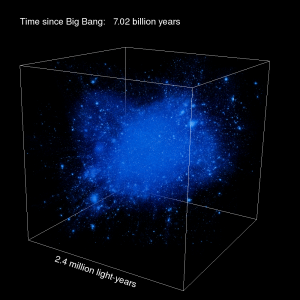Seeing the invisible
For instance, astronomers measure the motion of stars at the center of nearby dwarf galaxies to find clues about the dark matter holding them together. By increasing their simulation’s level of detail, the Via Lactea researchers could give astronomers predictions to compare against their observations or could suggest what to look for.

By this point, about 7 billion years after the Big Bang, gravity is pulling dark matter together into dense clumps. They gradually merge and are drawn toward the halo’s center.
Kuhlen and others in the group also seek ways to include the effects of visible matter in their simulation. “Up to this point we have taken the approach to ignore all the baryonic physics – all the normal matter. That will only work up to a certain point. As you increase resolution further and further you get into regimes where it’s important.”
This will be Via Lactea’s third iteration. The first came to life in spring 2006 as an application to test the then-new Columbia supercomputer at NASA’s Ames Research Center in California. “Since that worked and immediately produced interesting results, we tried to push it on higher and higher” in resolution, says Kuhlen, who at the time was a UCSC doctoral student under Madau.
The results helped earn the team its first INCITE grant. In November 2007, PKDGRAV2, the code that powers Via Lactea II, went through more than 1 million hours on 3,000 processor cores.
The ease with which the code ran on Jaguar is a tribute to Oak Ridge’s system, says Doug Potter, a member of the research team and a postdoctoral researcher at the University of Zurich’s Institute for Theoretical Physics. He and others on the team attended a workshop at the lab on how to use the computer effectively. After that, “It was a simple matter to get our codes running. Jaguar is set up and managed so well there wasn’t really any need for technical support.”
Tracking each dark matter particle obviously is impossible, even with the most powerful computer. So to model evolution of the dark matter halo around a galaxy similar to the Milky Way, Via Lactea II followed the interactions of about 1.1 billion particles, each with mass equivalent to about 4,000 suns.
The simulation began 20 million years after the Big Bang and followed the particles –with a combined mass of 1.7 trillion suns, representing the total dark matter in the system – over about 13.7 billion years. Gradually gravity draws the particles together from across a vast expanse of space, pulling them into small lumps that merge to become successively bigger lumps and clumps. Eventually the clumps come together in a “halo” massive enough to provide the gravity holding visible matter together in a galaxy.
In a Nature paper published in August 2008, the researchers said Via Lactea II showed that small dark matter lumps retain their structure even after merging into bigger clumps. Dark matter may be like Russian matryoshka dolls, they said, with small shapes inside successively bigger but similar shapes.
“We have high enough resolution that we can look at the internal structure of the lumps and they have little lumps inside them – substructures and sub-sub-structures and sub-sub-sub-structures, like nested dolls,” Kuhlen says. The simulations also show streams of dark matter flowing through the galactic halo.




